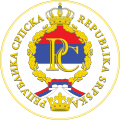 | |
| Тробојка/Trobojka (Tricolor) | |
| Use | Civil and state flag |
|---|---|
| Proportion | 1:2 |
| Adopted | 12 May 1992 |
| Design | A horizontal tricolor of red, blue and white |
The flag of Republika Srpska within Bosnia and Herzegovina was adopted on 12 May 1992. [1] [2] The flag is a rectangular tricolor with three equal horizontal bands of red, blue and white. [3] It is almost identical to the civil flag of Serbia, but with different aspect ratio of 1:2 instead of 2:3 and slightly different color shades.
Contents

In 2007, the Constitutional Court of Bosnia and Herzegovina declared the flag of the Federation of Bosnia and Herzegovina, the coat of arms of Republika Srpska, and other symbols of Republika Srpska unconstitutional. The court ruled that the symbols did not represent the non-Serb ethnicities living in Republika Srpska. However, the flag of Republika Srpska was deemed to be in line with the constitution. The court ruled that though the combination of the colors relates to the Serbian tricolor, the use of red, blue, and white are considered to be pan-Slavic colors as well.








